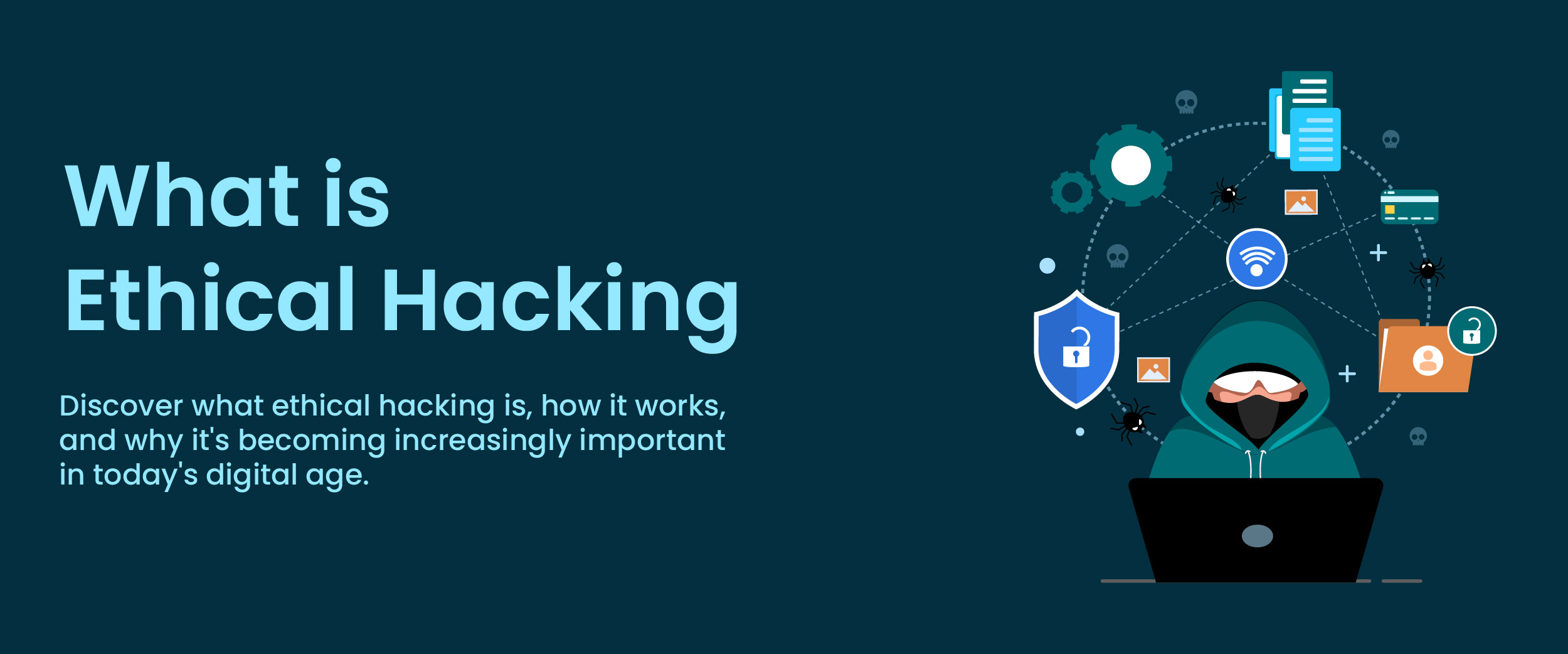What is Ethical Hacking?: Types, Advantages And More
Hacking is a word we hear almost every day but as there are two sides to everything, have you ever wondered if there is a positive side to hacking? In today’s world, it has become important to keep our data safe and protected. When it comes to confidential data that needs extra gatekeeping, ethical hacking has worked as a knight in shining armor.
So, what is ethical hacking? It is an authorized practice of detecting any vulnerabilities in software or application. Ethical hackers investigate the system or network to detect weak points. It improves security footprints and makes data more secure.
In this blog, we will learn more about ethical hacking meaning, its advantages and tools, and the types of ethical hacking.
Introduction to Ethical Hacking
It is the authorized method of checking the system’s vulnerabilities. Ethical Hacking protects confidential data that might be professional or personal. It is not about cracking passwords to steal data.
Finding potential risks to computers or networks needs practice and patience. Hence, it is necessary to know about hacking and take huge responsibility when you are liable for confidential data and networks.
The term used for ethical hackers is White Hat Hackers. It means hackers that work for the benefit of a company or network. They don’t steal or do illegal activities but have the right to detect any network vulnerability.
4 Types of Ethical Hacking
1. System Hacking
Hackers gain access to computers and networks through system hacking. Ethical hackers take defensive measures like password busting, packet sniffing, and malicious software construction to tackle these threats.
2. Social Engineering
Attackers lure people to share sensitive information. It is caused when people know less about the threats or trust attackers. Ethical hackers build a strong prevention password that strengthens security policies to combat this issue.
3. Web Application Hacking
It is a common method that hackers use by exploiting software over HTTP. Ethical hackers fix this by interfering with the URI (Uniform Resource Identifier) or by conspiring with HTTP aspects.
4. Wireless Networks
Hackers can easily extract information from wireless networks as it uses radio waves for transmission. Ethical hackers use network snorting to identify the hacker or debacle a wireless network.
Advantages of Ethical Hacking
To learn ethical hacking, one must be aware of the ethical hacking meaning and should have the right understanding and knowledge. Ethical hackers study the techniques and mindset of black hat hackers in order to track their activities. You can take an in-depth course in ethical hacking to excel in your career prospects.
The following are the advantages of ethical hacking:
- It is helpful for the company’s security and benefits them by gatekeeping important information.
- Ethical hackers work on network defending and risk management.
- It helps build a network that prevents any intervention from hackers.
- It helps fight against cyber terrorism and prevents security breaches.
- It helps track the identity of the black hat hackers and take preventive measures against them.
- It offers security to banking, financial, and confidential data of organizations.
Ethical Hacking Tools
There are various Hacking tools to help ethical hackers do their work with ease. Here are some of the commonly used tools:
- Acunetix: It is a fully automated and end-to-end web security scanning platform. It is used in Windows, Mac, RedHat 8, etc. It helps identify web application malfunctions and works as a security scanner.
- Intruder: Intruder is a cloud-based tool that helps find and fix vulnerabilities in a network.
- Nmap: Nmap helps in scanning the network to detect any possible vulnerabilities. It is used by ethical hackers in Mac OS, Linux, Solaris, and Windows.
- Metasploit: It is used in building anti-forensic and evasion tools. Ethical hackers use it in Mac OS, Linux, and Windows.
- Wireshark: This tool is best for analyzing data packets, and falls under the packet analyzer category. It is used in Linux, Windows, Mac OS, FreeBSD, NetBSD, and OpenBSD.
- Aircrack-Ng: It is a cross-platform tool, and supports any wireless network interface controller. It comes under the packet sniffer and injector.
Footprinting in Ethical Hacking
It is a technique used by ethical hackers to gather as much data as possible about a particular computer system. They use it to build infrastructure and seek opportunities to penetrate them. It identifies vulnerabilities in a computer or network. The process of footprinting includes organizations collecting data about networks or hosts.
Footprinting helps ethical hackers identify and fight potential vulnerabilities in a network. The information gathered by footprinting involves OS used by the organization. It also includes network maps, IP addresses, email addresses, and phone numbers.
There are two types of footprinting in ethical hacking:
- Active Footprinting: It involves active searches and techniques to collect data about a specific target. It takes professional knowledge about ethical hacking and the basics of this method.
- Passive Footprinting: It helps collect data about a particular target using harmless or passive methods. It includes using Google search, NeoTrace, or going through social media profiles. It is a furtive method of footprinting as it does not involve the target ID.
Conclusion
Ethical hacking is beneficial for protecting the networks and data in computers. It has been playing a significant role in tracking down the hackers that intrude on various systems to steal confidential data from them. There is a growing demand for ethical hackers. So, it is important for them to be aware of the ethical hacking basics.






